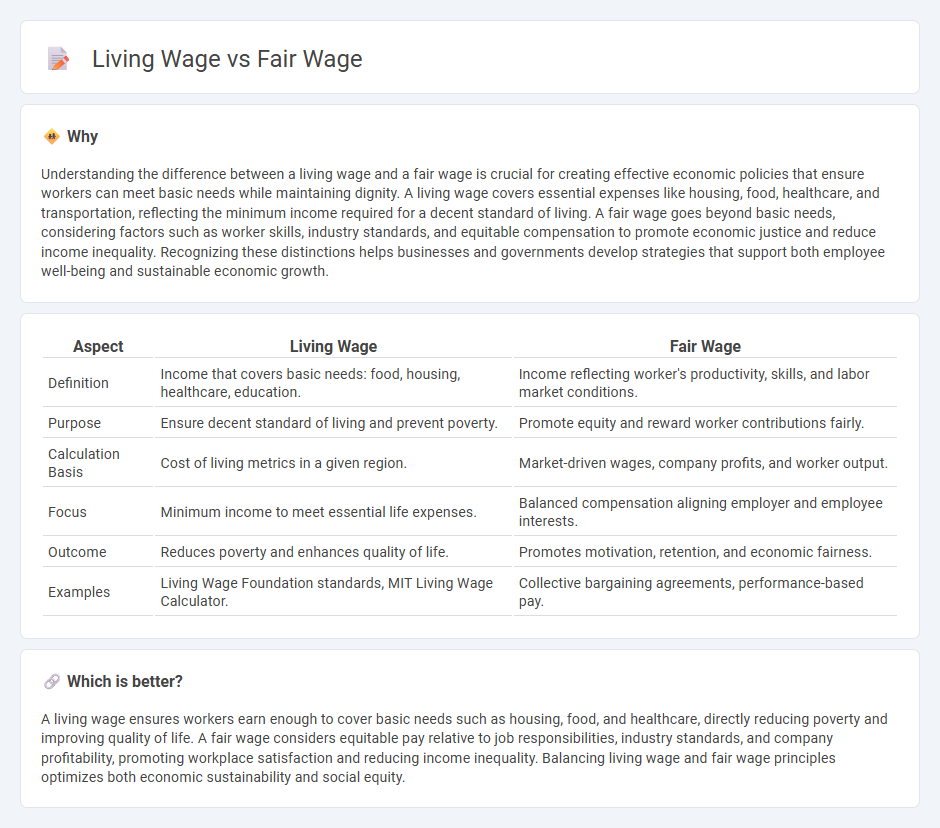
Living wage ensures individuals earn enough to cover basic necessities such as housing, food, and healthcare, reflecting the actual cost of living in a specific area. Fair wage incorporates broader ethical considerations, including equitable pay relative to company profits and workers' skills, aiming for justice beyond mere survival. Explore the distinctions and impacts of living wage versus fair wage on economic stability and social equity.
Why it is important
Understanding the difference between a living wage and a fair wage is crucial for creating effective economic policies that ensure workers can meet basic needs while maintaining dignity. A living wage covers essential expenses like housing, food, healthcare, and transportation, reflecting the minimum income required for a decent standard of living. A fair wage goes beyond basic needs, considering factors such as worker skills, industry standards, and equitable compensation to promote economic justice and reduce income inequality. Recognizing these distinctions helps businesses and governments develop strategies that support both employee well-being and sustainable economic growth.
Comparison Table
| Aspect | Living Wage | Fair Wage |
|---|---|---|
| Definition | Income that covers basic needs: food, housing, healthcare, education. | Income reflecting worker's productivity, skills, and labor market conditions. |
| Purpose | Ensure decent standard of living and prevent poverty. | Promote equity and reward worker contributions fairly. |
| Calculation Basis | Cost of living metrics in a given region. | Market-driven wages, company profits, and worker output. |
| Focus | Minimum income to meet essential life expenses. | Balanced compensation aligning employer and employee interests. |
| Outcome | Reduces poverty and enhances quality of life. | Promotes motivation, retention, and economic fairness. |
| Examples | Living Wage Foundation standards, MIT Living Wage Calculator. | Collective bargaining agreements, performance-based pay. |
Which is better?
A living wage ensures workers earn enough to cover basic needs such as housing, food, and healthcare, directly reducing poverty and improving quality of life. A fair wage considers equitable pay relative to job responsibilities, industry standards, and company profitability, promoting workplace satisfaction and reducing income inequality. Balancing living wage and fair wage principles optimizes both economic sustainability and social equity.
Connection
Living wage and fair wage both center on ensuring workers receive adequate compensation to meet basic living costs and maintain a decent standard of living. A living wage reflects the minimum income necessary for essential needs like housing, food, and healthcare, while a fair wage incorporates broader principles of equity, considering job role, skill level, and economic conditions. Together, these concepts promote economic justice, reduce poverty, and support sustainable consumer spending within the economy.
Key Terms
Cost of Living
A fair wage aims to provide employees with reasonable compensation based on their role, skills, and industry standards, whereas a living wage specifically addresses the cost of living, ensuring workers can afford basic necessities such as housing, food, and healthcare. The cost of living varies significantly by region, making a living wage a dynamic benchmark that reflects local economic conditions and inflation rates. Explore how living wages impact economic stability and social equity in different communities.
Minimum Wage
Minimum wage sets the legal lowest hourly pay employers can offer, often lacking alignment with the actual cost of living, causing many workers to struggle despite full-time employment. A fair wage considers productivity and equity, aiming for pay that respects the value of labor, whereas a living wage ensures earnings cover essential expenses for a decent standard of living, including housing, food, and healthcare. Explore the distinctions and implications of these wage standards to understand their impact on economic justice and worker well-being.
Purchasing Power
A fair wage ensures employees receive compensation aligned with their skill level and industry standards, while a living wage specifically covers the basic cost of living, including housing, food, and healthcare. Purchasing power is crucial in evaluating these wages, as it determines the real value of income in meeting everyday expenses amid inflation and regional cost differences. Explore detailed comparisons and economic impacts to understand how these wages affect workforce stability and quality of life.
Source and External Links
Living Wage - Fair Labor Association - Defines fair wage as compensation sufficient to meet a worker's basic needs and allow some discretionary income, with global efforts to close the gap between actual wages and living wages in supply chains.
One Fair Wage: Home - Advocates for fair wages for millions of U.S. restaurant and service workers, focusing on eliminating subminimum wages and ensuring decent pay in the service sector.
What Constitutes a Fair Wage? - Society and Business Anthology - Explains that a fair wage usually means higher wages for low- and middle-income workers, considering factors like cost of living, inflation, and the ability to support a family.
 dowidth.com
dowidth.com